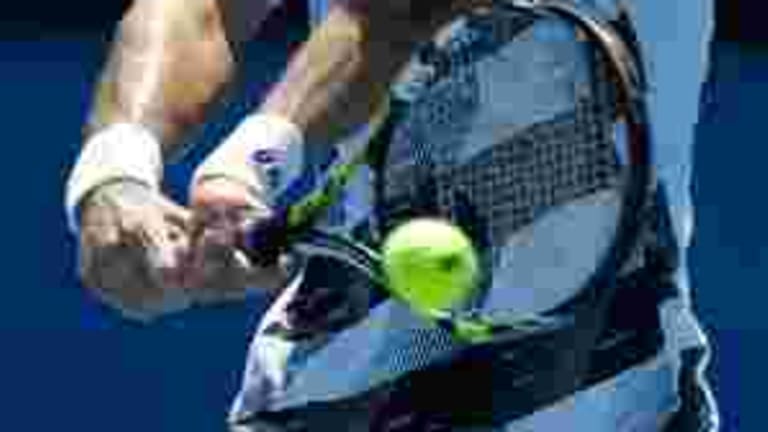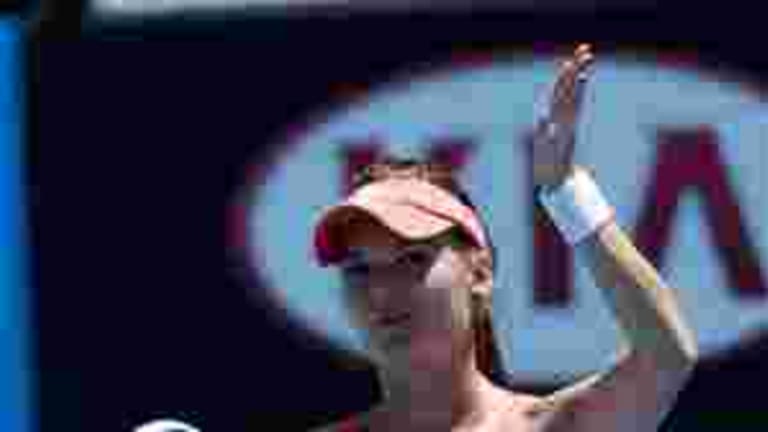My appetite for the Australian Open was whetted by a magnificent weekend of NFL playoff football. So you can imagine what a downer it was when I flicked the channel over to ESPN2, and about the first thing I saw was that precious commercial for Melbourne tourism—you know, the one featuring the “I want to know where you go when you’re gone” song (officially, “A Heart Divided” by folkie Holly Thorsby).
I want to know where you go. . . I just wish the commercial would go away. Are we going to be subjected to this ad for every Australian Open going forward?
Well, it was a rocky start, and I must say I also was disappointed to see that the color scheme of the courts remains blue-on-blue. It’s too much, for me. A hard court is a pretty sterile, severe-looking thing; it doesn’t even have those intriguing circles and hemispherical boundaries that define a basketball court or hockey rink. I much prefer to see a significant contrast between the actual field of play inside the lines and the surrounding territory.
But when it comes to the tennis I watched, no complaints. None at all. It was good stuff, at times bordering on great stuff, from the get-go. And hopping around the courts, I was reminded once again of just what it means to be a. . . Player—with an upper case “P.” That is, someone with an intrinsic understanding of the game, not in terms of backhands and forehands, or inside-out vs. down-the-line, but of what it takes to win matches regardless the mechanics or “Xs and Os.”
There isn’t a better present-day example of the kind of player I’m talking about than young American Steve Johnson, who’s still so new to the pro ranks that instead of a mug shot, the Australian Open’s website features the message, “Photo not available.”
The 23-year-old Johnson is no prodigy. His 20-year-old countryman Ryan Harrison, who started taking his lumps on the pro tour as soon as he was able, is already ranked more than 100 places higher on the ATP computer (No. 175 vs. No. 62). Johnson, an Orange County lad, followed the model created by John Isner. Like the former Georgia Bulldog, Johnson remained in college (USC) and enjoyed a brilliant career there, winning the NCAA singles title in his junior and senior seasons.
Well, that’s over now, and there he was, hoping to qualify for the Australian Open main draw last week. It didn’t go so well, or at least that thought must have flashed through Johnson’s mind right about the time that he and 16-year-old Thanasi Kokkinakis of Australia were deadlocked at 15 games apiece in the third and final set of their first-round qualifying match. Johnson pulled out that match, , and went on to win two more matches—the latter over fellow American Ryan Sweeting, who’s had considerable tour experience—to make the big show.
Johnson drew No. 10 seed Nicolas Almagro as his first-round opponent. That’s a tough break; Almagro’s a bullish player who, were he a little taller than his listed 6’0”, would be even more of a threat to the established order. The match went the distance—five grueling sets—before Almagro put Johnson away, 7-5. 6-7 (4), 6-2, 6-7 (6). 6-2. And if you stumbled across this result on the Internet or at the arena, you might have been surprised to see that Almagro had so much trouble. That’s because Almagro looks so strong, so good, so, professional.
By contrast, Johnson looks like . . . well, an enthusiast. His desire is conspicuous, as is his high level of energy; but those features, combined with his vulnerable backhand, only add to this impression that he’s an amateur, out in a brave, bad new world with a homemade, old-schoolish game in which the slice backhand figures a little too prominently.
Southern California has always produced individuals whose labors in the basement or garage created something unique and lasting—check out surfboards, or the history of the hot rod. Johnson’s father, a teaching pro, developed Steve’s game since the boy was two. Yet Johnson is a testament to the concept of unique identity; watching him, you might be surprised to learn that he’s had formal training at all. His game seems less learned than something natural, like his fingerprint.
Interviewed on ESPN during Johnson’s match, USTA national coach Dustin Taylor said of Johnson’s future: “We need to clean some things up in his game.”
As wise an idea as that may be, it seems to miss the point. Johnson is, first and foremost, a competitor—a Player. A guy who wants to win, who knows how to win, period. It’s as if he doesn’t—and doesn’t need—to know how good or bad his backhand or serve or volley is. And a knack for winning is a great gift and facility in a world choc-a-block with good athletes who have been trained to hit a sweet, Federer-esque forehand, or a compact, laser-like Djokovic-like backhand.
In this, Johnson is a little like Alberto Berasategui (a former Roland Garros finalist), or even Jay Berger, current USTA head of men’s tennis. Johnson didn’t get where he is because he had pretty strokes. He’s living proof that it’s not about technique, even if one definition of genius in tennis may be that it’s the perfect marriage of competitive ability with exquisite, or radically effective, technique.
Being a great competitor won’t necessarily win you the Australian Open, but then just having a beautiful game won’t do it either.

